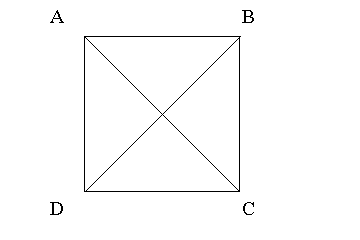
You should be familiar with various methods for obtaining the angle between two stations. To survey a quadrilateral (e.g. for strain measurements) you should follow the method outlined below. The objective is to determine angles as accuratly as possible. Sometime this may require taking more readings than is suggested below (other time, less readings are required). The order in which the readings are taken is important! For example you should not take three F1/F2 readings to B, then three to C and three to D (from point A). You should use the order shown in part 3 below.
The corners of the quadrilateral should be labeled A, B, C, D, in a clockwise direction. That is, if you are standing at A, looking at the opposite corner – C – , D will be on your right, and B on your left.

1) Make a sketch of the quadrilateral in your notebook. Record project, time, date, name of survey crew. All of this is important. Since we are looking for changes in angles and lengths over time, we need to know when the readings were made.
2) If you are using a SDR33 notebook, you should still make a sketch in a notebook. You should record the point numbers used in the SDR for each round of readings. I suggest that you do not use the point averaging in the SDR33 — that is, never change a point number, only change the label. The more advanced users of SDR33 notebooks may wish to use the set collection program.
3) Set the instrument at A. Use the 0-SET on the instrument to set zero just counterclockwise of point B (this helps make life simple!).
- Check that B,C, & D are level and over the benchmarks
- Measure the height of all tripods
- Take a F1 reading to B – check that the label and tripod height are correct
- Take a F2 Reading to B – check that the label and tripod height are correct
- Take a F1 reading to C – check that the label and tripod height are correct
- Take a F2 reading to C – check that the label and tripod height are correct
- Take a F1 reading to D – check that the label and tripod height are correct
- Take a F2 reading to D – check that the label and tripod height are correct
- On the first cycle record the readings in your notebook. You can use this to check your other readings as they are taken. You should also use the first set of readings to check that the sum of the angles is correct for the various triangles in the quadrilateral. This may help you detect a bust.
Repeat the above procedure two more times (for a total of 9 pairs of readings)
4) Move the instrument to station B. Make measurements to A, D, and C as described above. Before starting, make sure that all reflectors are level and exactly over you points.
5) Move the instrument to station C. Make measurements to D, A, and B as described above. Check reflectors are level and over the points.
6) Move the instrument to station D. Make measurements to A, B, and C as described above. Before starting, make sure that all reflectors are level and exactly over you points.
7) When done you should have eight angles and six lengths. From here you can check the quality of your measurements and make any necessary adjustments. You should see the web page on adjusting quadrilaterals. Sample adjustments of the raw data are available in this Excel workbook. Once you have adjusted the raw data you can use Least-squares to adjust the quadrilateral (Excel workbook for least-squares adjustment).
Questions? Comments? Contact CruikshankK@pdx.edu
Page last updated: April 02, 2005